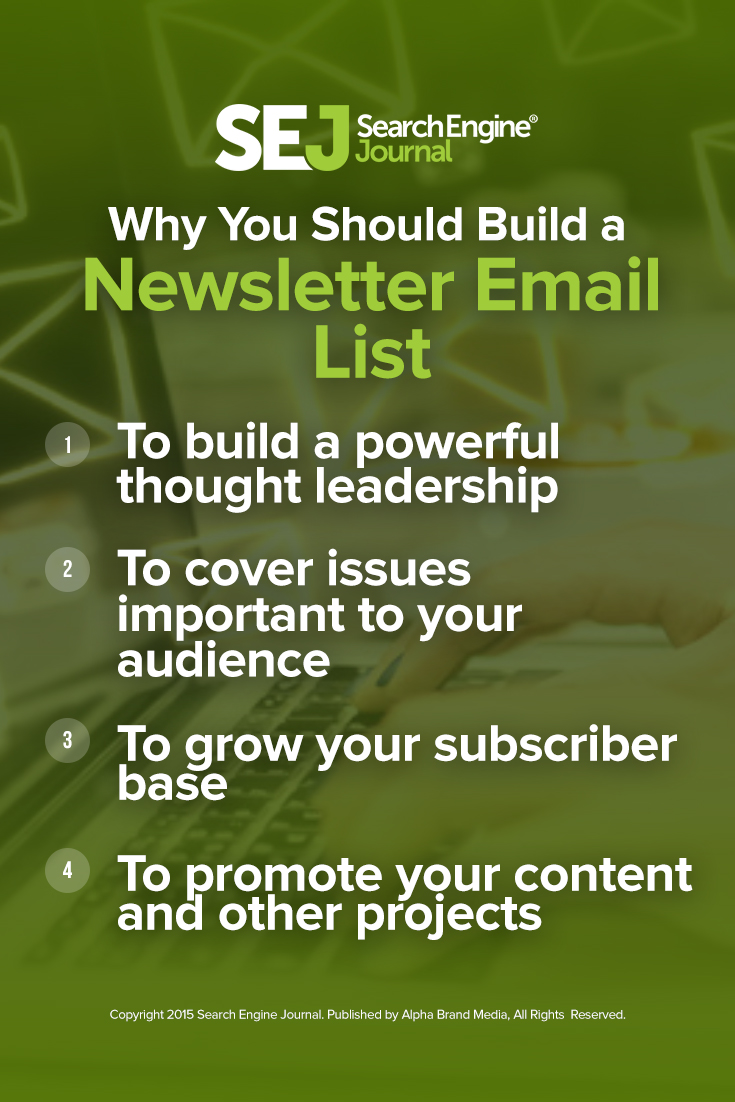For marketers, it’s hard to consider creating an initiative without a definite ROI purpose behind it, especially if you’re using time and resources to push it out. However, there are some types of content and marketing that — while they may not produce a strong, direct revenue — their long-term benefits outweigh the potential short-term income.
One such medium is a newsletter, which is sent to your email list on a regular basis. The frequency may vary depending on content and availability to create newsletters, but most are usually sent once per month. When it comes to specific days, Tuesday through Thursday are usually best.
According to WordStream, Thursdays from 8 to 9 am are the best time of day to send out an email blast, which coincides with MailChimp’s findings.
No matter when it’s sent, newsletters can be a worthwhile endeavor, especially if you are personally curating it or doing the research to include links, illustrations, and other enticing information.
Below are a few benefits of building an email newsletter mailing list — outside of trying to create income.
Grow Thought Leadership
Newsletters can help you build a powerful presence among your target audience. Many consultants and businesses send out curated newsletters that are chock full of links, industry news, and insights they don’t share on their blog. This builds up the exclusivity of the newsletter.
Newsletters are a great way to set yourself (or your organization) up as a thought leader in your industry. For instance, social media strategist Scott Monty just started a weekly newsletter called The Full Monty, which he discussed on a Marketing Nerds podcast with me.
Scott not only includes the top stories in marketing and social media for the week, and adds his personal insight on the developments. This is helpful to his email list because he is offering advice on how the industry is going to shift with the changes. This keeps the audience feeling like they are in an ongoing conversation with Scott, which could lead to referrals or reaching out when they need help with their own social media or marketing.
Further The Industry
Lena Dunham is known for pushing the envelope when it comes to talking about feminist and millennial issues. Her latest endeavor, Lenny Letter with her friend Jenni Konner, is a twice-a-week newsletter that covers feminism, politics, friendship, exclusive celeb interviews, and more. Versions of the articles are also hosted on their website, after a delay.

While Lenny Letter now has a partnership with Hearst Magazines for advertising, it was created by Lena and Jenni as a way to further conversations that are important to women. The advertising in Lenny Letter will be used to make sure the operation is self-sustaining, as it now has a full-time staff of three and pays its artists and contributors.
A Slate editor recommended the newsletter format and Lenny Letter has been a success ever since: According to Nieman Lab, it has grown to over 400,000 subscribers with a 65 percent open rate.
By covering issues that are important to their target audience, the newsletter has continued to blossom. It frequently gets mentions in the mainstream news for its thought-provoking essays and interviews, which was its main purpose—to get people talking.
To Grow a Subscriber Base
A regular high-quality letter can also be a great way to grow your subscriber base, whether or not you are already sending out regular emails. By offering a regular newsletter, you are giving your audience a break from all your marketing emails to take in something of value.
By promoting the valuable information in the newsletter, you may drive more email subscriptions. Market to the exclusivity of the newsletter and explain what information it will contain that subscribers won’t get anywhere else.
Then, if the newsletter is tying into an ongoing email marketing campaign, make sure your email send frequency isn’t driving unsubscribes through overkill. Depending on the industry, daily emails are tolerated, while in others, a daily email would kill engagement and click-through rates. Make sure you do your research to ensure you aren’t exhausting your mailing list.
To Promote Your Content and Other Projects
 Besides sharing insight on industry news and articles, an email newsletter is also a great place to share your own content, as well as other projects you have coming down the pipeline. As long as your newsletter is a good mix of more external information that promotions, the mentions will come across as natural. And because your audience has begun to think of you or your company as an industry thought leader, they will look forward to hearing about new content you’ve written.
Besides sharing insight on industry news and articles, an email newsletter is also a great place to share your own content, as well as other projects you have coming down the pipeline. As long as your newsletter is a good mix of more external information that promotions, the mentions will come across as natural. And because your audience has begun to think of you or your company as an industry thought leader, they will look forward to hearing about new content you’ve written.
Besides new blog posts, you can also promote:
- Upcoming conferences or speaking engagements
- New podcasts or webinars
- Books, e-books, or white papers
When mentioning any of these, be sure to come at from a value-added proposition—meaning that you need to explain why reading what you’re mentioning will solve the reader’s problem. By using a solution-based approach, instead of an attribution view, your audience will personalize the content and how it could help them. Customers enjoy being educated in ways that are going to help their home or business, and all content you create or promote should keep that in mind.
Because It’s Fun
Finally, creating a newsletter doesn’t have to have a set reason other than it’s fun or that you want to do it. There are tons of really great newsletters that have thousands of subscribers and were created simply because the company or person thought it would be fun.
One great example of this is writer and podcaster Ann Friedman’s weekly newsletter, which has over 24,000 subscribers. She just started selling premium subscriptions (currently $5/year) and classified spots in 2015, but overall, her newsletter is just a place for her to share cool articles, videos, and news she’s found online. She occasionally posts about upcoming live podcast recordings (Call Your Girlfriend, her pop culture and news podcast with her long-distance BFF is hilarious) and other events, but otherwise, her newsletter is largely organic, which is why so many people look forward to it every Friday.
If you’re looking for a way to start an email newsletter to share links, insight, and more, TinyLetter from MailChimp is popular with many bloggers and thought leaders that have wanted to focus on building highly targeted newsletters. (Fast Company said in 2013 that it “made them fall in love with email again.”)
Another way to make a newsletter that shares links or information is Curated, which lets you save links as you’re browsing. You can then go in and add commentary, personalized layouts, and more. Curated is $25/month up to 500 subscribers, and goes up from there.
The Takeaway
Whether you’re using Curated or a good ol’ email service like Constant Contact or MailChimp, building an email newsletter that doesn’t have revenue generation as its main purpose can help you build your list, grow your thought leadership, and promote your other projects. Focus on quality, experiment with send times and layouts, and your email newsletter should bring you many benefits for years to come.
Want to learn more about building a newsletter list that doesn’t focus on making the big bucks? Check out my podcast with best-selling author Ryan Holiday:
Want to listen to more Marketing Nerds? Subscribe via iTunes, Stitcher, or RSS.
Editor Note: SEJ and author are not affiliated with any of the companies or services mentioned in any way.

Images via Shutterstock, Screenshot taken March 2015.




